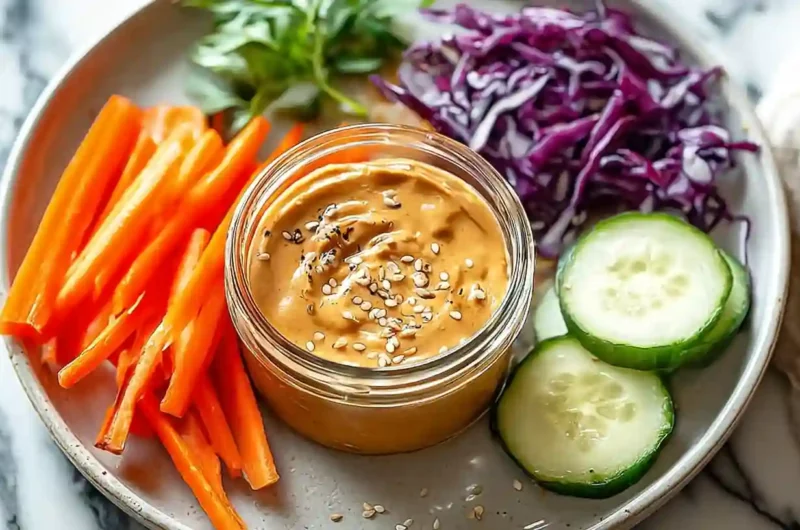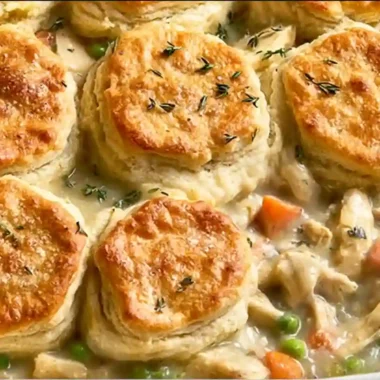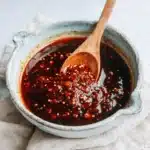Some sauces impress with complexity. This one wins with simplicity and bold flavor. Thai peanut sauce has always been my go-to for transforming plain veggies, noodles, or grilled proteins into something crave-worthy. I remember the first time I made it—no cooking, just a bowl and a whisk. Five minutes later, I had magic.
This recipe delivers what you want fast. It’s rich, creamy, and packs a punch of savory, sweet, tangy, and spicy all at once. Whether you’re dipping, drizzling, or marinating, this sauce fits every role.
In this guide, you’ll get the exact recipe, tips for perfect consistency, ingredient swaps, and smart serving ideas. By the end, you’ll have your own signature version of this classic.
Why You’ll Love This Thai Peanut Sauce
It’s not just a sauce, it’s a kitchen shortcut to better meals. You can use it as a dip for spring rolls, a dressing for salads, a quick stir-fry sauce, or even a marinade for tofu and grilled chicken.
Short on time? This sauce comes together in five minutes with basic pantry ingredients. No blender, no stove, no stress.
Got dietary preferences? No problem. You can easily swap ingredients to make it vegan, gluten-free, nut-free, or spicier if you like. It’s endlessly flexible and always delicious.
Table Of Contents
Ingredients You’ll Need
This simple sauce uses everyday ingredients. Here’s what you’ll need, grouped for clarity.
For the Base
- Natural peanut butter, about half a cup, unsweetened and smooth for the best texture
- Low sodium soy sauce, two tablespoons, or swap with tamari or coconut aminos if you need it gluten-free
- Rice vinegar, one tablespoon, for a bit of tang
- Brown sugar, two tablespoons, to balance the salty and spicy flavors
For the Flavor Kick
- Chili garlic sauce, two teaspoons, more or less depending on your spice preference
- Fresh lime juice, one tablespoon, adds brightness
- Garlic cloves, three, either pressed or finely grated
- Grated fresh ginger root, about one tablespoon, for that warm depth
To Adjust the Texture
- Warm water, start with two tablespoons and add more if needed to reach your preferred consistency
These ingredients blend together for a rich, creamy sauce that works on just about anything.

How to Make Thai Peanut Sauce
Making this sauce is as simple as it gets. Follow these clear steps for perfect results every time.
- Start with the base ingredients
In a medium mixing bowl, add the peanut butter, soy sauce, rice vinegar, brown sugar, chili garlic sauce, lime juice, grated garlic, and ginger. - Whisk until smooth
Use a whisk or fork to blend everything together. Stir thoroughly until the mixture looks creamy and even. If the peanut butter is thick, let it sit for a minute at room temperature to loosen up. - Adjust the consistency
Slowly add warm water, one tablespoon at a time. Stir after each addition to check the texture. Two tablespoons will give you a thick dip. If you’re making a dressing, keep adding water until it’s pourable. Four tablespoons usually gives a smooth, light sauce. - Taste and tweak
Give it a taste. Want it sweeter? Add a pinch more sugar. Need more tang? A splash of lime juice will help. Too spicy? Stir in a little extra peanut butter to calm the heat.

Once you reach your perfect balance, your Thai peanut sauce is ready to serve or store.
The Science of Flavor
Peanut butter is rich and fatty, which gives the sauce its creamy body. But without balance, it can taste flat. That’s where vinegar and lime juice come in. Their acidity cuts through the richness, brightening the flavor and making the sauce feel lighter on the palate.
Ginger plays a key role in Thai cooking for a reason. It adds warmth and a hint of spice, but also depth. Its slightly peppery, citrusy notes help round out the sauce and make it more complex, tying together sweet, salty, and tangy elements in every bite.
Ingredient Substitutions table
| Ingredient | Substitute | Important Notes |
| Peanut Butter | Almond butter | Milder flavor, still creamy and rich in healthy fats |
| Sunflower seed butter | Nut-free option, slightly earthy taste | |
| Cashew butter | Slightly sweeter, smooth texture | |
| Soy Sauce | Tamari | Gluten-free option with similar salty umami taste |
| Coconut aminos | Soy-free and lower in sodium, slightly sweeter | |
| Brown Sugar | Honey | Adds floral sweetness, not vegan |
| Agave nectar | Vegan and neutral in flavor | |
| Maple syrup | Rich, deeper sweetness, great for layering flavor | |
| Rice Vinegar | Apple cider vinegar | Slightly more tangy, still light and fruity |
| White wine vinegar | Clean acidity, works well but a bit sharper | |
| Fresh Garlic | Garlic powder | Use a small pinch, less sharp but adds background flavor |
| Fresh Ginger | Ground ginger | Milder and more earthy, use about one-third the amount |
| Chili Garlic Sauce | Sriracha | Similar heat with a slightly different flavor profile |
Serving Ideas: What to Eat with Thai Peanut Sauce
This sauce does it all. Here are some tasty ways to use it.
As a Dip
Pair it with fresh spring rolls, raw veggies like carrots and cucumbers, or grilled chicken skewers.
Over Noodles
Toss it with rice noodles or soba for a quick peanut noodle bowl. Add shredded veggies or tofu for a full meal.
As a Marinade
Use it to marinate tofu, chicken, or shrimp before baking or grilling. Let it sit for at least 30 minutes for deeper flavor.
On Salads and Bowls
Drizzle it over grain bowls, buddha bowls, or chopped salads. It adds instant richness and bold taste.
With Stir-Fries
Stir it into veggie or protein stir-fries right at the end of cooking for a creamy, spicy finish.
Use it wherever you want a mix of salty, sweet, tangy, and spicy. This sauce never goes out of place.
Want more homemade sauce ideas? Try pairing grilled meats or roasted veggies with our Easy and Fresh Hot Sauce or spice things up with a bold Habanero Hot Sauce.
Troubleshooting and Expert Tips
My sauce is too thick or too thin
If it’s too thick, slowly stir in warm water until it loosens up. If it’s too thin, add a bit more peanut butter and whisk again until it thickens.
My sauce is separating
This can happen if the ingredients aren’t well blended. Whisk longer or use a blender to bring it back together. Make sure the peanut butter is at room temperature to help it mix smoothly.
What’s the best way to blend the sauce
A whisk works fine for small batches and fewer dishes to clean. A blender gives you a super creamy texture, great if you’re doubling the recipe. A food processor is another option but can be harder to clean.
How to adjust the spice level
Too spicy? Add a little more peanut butter or a splash of coconut milk to cool it down. Not spicy enough? Stir in more chili garlic sauce or a touch of sriracha. Always taste as you go to find your perfect balance.
Storage and Meal Prep Tips
Refrigerator Storage
Keep your peanut sauce in an airtight container in the fridge. It stays fresh for up to one week. The sauce may thicken over time, so just stir in a bit of warm water before using.
Can You Freeze Thai Peanut Sauce
Yes, you can freeze it. Pour the sauce into freezer-safe containers or silicone ice cube trays. Once frozen, transfer cubes to a sealed bag. It keeps well for about three months. Thaw in the fridge overnight and stir well before serving.
Meal Prep Ideas
Make a big batch and use it throughout the week. Spoon it over grain bowls, toss it with noodles, or drizzle it on roasted veggies. It’s a great way to make fast meals taste homemade and satisfying.
Comparing Preparation Methods
Not all tools give the same result when making Thai peanut sauce. Here’s how each method works and when to use it.
Hand Whisk
Best for small batches and quick cleanup. Use this when your peanut butter is soft and your ingredients are at room temperature. It gives a slightly rustic texture, perfect for dipping and casual meals.
Blender
Great for ultra-smooth sauce. Use this method if you’re doubling the recipe or your peanut butter is thick. A blender creates a silky finish that’s ideal for drizzling over noodles or salads.
Food Processor
Useful when adding solid ingredients like peanuts or fresh herbs. It handles thick mixtures well and gives a creamy texture with a bit of texture left behind. Choose this if you want a thicker, scoopable sauce with a little bite.

Thai Peanut Sauce: Easy, Creamy, and Ready in Minutes
Ingredients
Method
- In a medium mixing bowl, add the peanut butter, soy sauce, rice vinegar, brown sugar, chili garlic sauce, lime juice, grated garlic, and ginger.
- Use a whisk or fork to blend everything together. Stir thoroughly until the mixture looks creamy and even. Let it sit if the peanut butter is thick.
- Slowly add warm water, one tablespoon at a time, stirring after each addition to check the texture. Add more water for a pourable sauce.
- Taste the sauce. Add more sugar, lime juice, or peanut butter to adjust sweetness, tang, or spice level as desired.
- Once you’re satisfied with the balance and texture, the sauce is ready to serve or store.
Notes
- Prep Time: 5 minutes
- Cook Time: 0 minutes
- Total Time: 5 minutes
- Servings: 4
- Calories: 226 kcal per serving
- Calories: 226 kcal
- Carbohydrates: 15 g
- Protein: 9 g
- Fat: 16 g
- Saturated Fat: 3 g
- Sodium: 540 mg
- Potassium: 233 mg
- Fiber: 2 g
- Sugar: 9 g
- Vitamin C: 1.8 mg
- Calcium: 23 mg
- Iron: 0.8 mg
- Course: Sauce, Dip, Dressing
- Cuisine: Thai, Asian-inspired
- Diet: Vegan, Gluten-Free (with substitutions)
- Method: No-Cook
- Keyword: Thai peanut sauce, peanut dipping sauce, vegan peanut sauce
- Skill Level: Beginner
Why This Thai Peanut Sauce Is a Must-Try
This sauce checks every box. It’s fast, full of flavor, and works with just about anything. Whether you’re dipping, drizzling, or marinating, it delivers bold taste with minimal effort. You don’t need fancy tools or hours in the kitchen to make something this good.
What sets it apart is its flexibility. Vegan or gluten-free? No problem. Need it mild or fiery? Easily adjusted. You can make it your own with simple tweaks.
Tried this recipe? Drop a comment below and leave a star rating to let others know how it turned out.
Share it with friends on Facebook or Pinterest. We’d love to see your creations too. Tag us if you post it online.
What did you pair your sauce with? Any fun twists? Tell us below.
For more details on the nutritional values of ingredients used in this recipe, visit the USDA Food Database.
Frequently Asked Questions
What are the ingredients in Thai peanut sauce?
Typical ingredients include peanut butter, soy sauce, rice vinegar, lime juice, garlic, ginger, a touch of sweetness like brown sugar, and chili garlic sauce for heat.
How to make homemade peanut sauce easily?
Mix all the ingredients in a bowl, whisk until smooth, then adjust the thickness by adding warm water. No cooking or special tools required.
What are the ingredients in pretty Thai peanut sauce?
“Pretty Thai” peanut sauce often refers to a specific brand or variation. Ingredients usually include peanut butter, soy sauce or tamari, vinegar, sweetener, garlic, and spices like chili or ginger.
What is the difference between satay and peanut sauce?
Satay sauce is a type of peanut sauce, but not all peanut sauces are satay. Satay sauce usually includes coconut milk and is used with grilled meats, while general peanut sauce can vary and be used more broadly.
What is the best type of peanut butter to use?
Use smooth, natural, unsweetened peanut butter for the best results. It mixes easily and gives a rich, clean flavor without added sugar or oil.
Is this recipe vegan?
Yes, it is vegan if you use a plant-based sweetener like maple syrup or agave instead of honey, and check that your soy sauce or alternative is vegan-friendly.
Is this recipe gluten-free?
It can be gluten-free if you use tamari or coconut aminos in place of regular soy sauce. Always double-check your labels to be sure.









